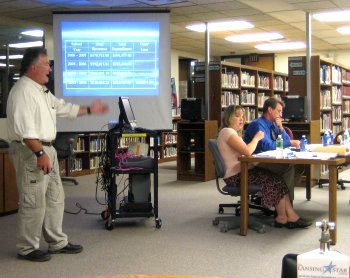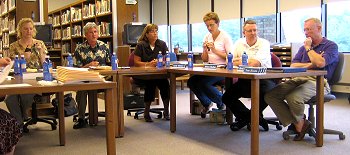- By Dan Veaner
- News
 Print
Print 
Lawrence brought the issue to the board, because he said it is time to raise prices to offset losses. He said he had consulted with Director of After School Program Ron Frost, who recommended a slight increase to bring profit/loss to 0%. Lawrence proposed a new rate structure that raise the daily rate from $9.00 to $9.50, and the full day program from $20.00 to $23.00. He said that Frost estimated that the program would pay for itself with no gain, but no loss based on these new rates.
| |||
Lawrence said that the program should be earning a profit, but that Frost's concerns that a price rise would result in students dropping out of the program could mean more loss and another price rise next year. "Ron prevailed upon me to be concerned about that demand," he said. "This is an enterprise fund, just like the cafeteria fund. We should be making money on this."
I've got to disagree with that," said board member Bonita Lindberg. "I think the service for the children and for families belies the economics. I work because child care works. If I don't have the right child care and I'm not working it affects the whole economy of the community. I think if you price this out of the market that we have an issue with latchkey kids, kids who are getting on the bus, elementary school kids who get off the bus and nobody is there because Mom and Dad have to go to work."
"I understand that there is a welfare function here," Dittman replied. "But is that our role as a school board to engage in that, or is our role to engage in education? Children staying after school is certainly part of education, but if this is an enterprise activity let's not price this as a welfare activity. Let's price it as an enterprise activity, and let's try to get rid of the $70,000 deficit or we're going to be facing the taxpayers with a larger deficit -- $200,000 or $300,000 -- down the road."
Lawrence noted that the program was part of the general fund until this year, when it switched to become part of a federal enterprise fund. He explained that it already showed as a loss in the general fund, meaning it was already paid for by taxpayers. "This is the first year that it would be a due to/due from the federal fund," he said. "That fund has to be self-sustaining. So there is going to have to be something done this year because of the way that it was accounted for before."
Some board members questioned whether other districts run similar programs. Sandi Dhimitri asked what those programs charge, but nobody knew the answer. "This is a public school program," Lawrence said. "It is very unusual for a district to have this. It's allowed because it's a related activity."
"I would contend that you are going to lose representation in this program at a 12% increase, not a %12 1/2 increase," Dittman said. "So anybody that you're going to lose, you're already going to lose. So I would go for it. And when you lose them you're going to run the program and lose even more. You'd better price it right so you are priced for a reduction in volume. If you really think the volume is going to be reduced, then price it for the reduction in volume."
 School Board (left to right) Vice President Anne Drake, President Tom Keane, Bonita Lindberg, Sandi Dhimitri, Mike Cheatham, David Dittma |
The idea of taxpayers subsidizing some parents' child care didn't sit well with some who attended the meeting. "This was never part of the general fund budget that we voted on as a community," said former District Business Administrator Tom Jones. "What would your accountants, and for that matter, your attorneys say about spending money on the program? You're really subsidizing a program that is outside the general fund. What's the legality of it?"
The board decided to submit questions by e-mail to Superintendent Mark Lewis, who said he and Lawrence would follow up with answers and new projections that take less demand into account, and provide for making up the deficit over a period of time.
----
v3i27



